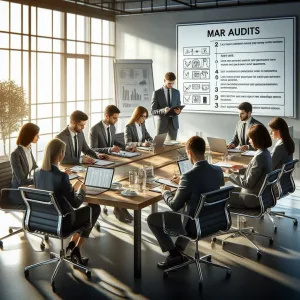In today’s digital landscape, the reliance on technology has never been greater, making organizations increasingly vulnerable to cybersecurity threats. As business leaders, understanding the significance of IT audits is essential for safeguarding your organization’s data and systems. This blog explores their critical role in enhancing cybersecurity posture and provides actionable insights for effective implementation [1].
What is an IT Audit?
An IT audit is a systematic evaluation of an organization’s technology infrastructure and processes. Its primary objectives are to identify vulnerabilities, assess compliance with internal policies and regulatory requirements, and provide recommendations for improvement. The process involves several key steps [2]:
- Planning and Risk Assessment: Identify business objectives and associated risks.
- Data Collection: Gather information about IT systems, including hardware, software, and user access controls.
- Control Evaluation: Assess the design and operating effectiveness of internal controls.
- Testing and Validation: Perform hands-on testing to validate control effectiveness.
- Reporting and Recommendations: Document findings and provide actionable recommendations.
Types of IT Audits
- Financial: Ensure the accuracy of financial data processed through IT systems.
- Operational: Evaluate the efficiency of IT systems in supporting business processes.
- Compliance: Assess adherence to regulatory requirements and internal policies.
Tools and Techniques Used in IT Auditing
- Audit Software: Automates data collection and analysis.
- Network Scanning: Identifies vulnerabilities in network configurations.
- Penetration Testing: Simulates attacks to test defenses.
- Interviews and Surveys: Gather insights from stakeholders about processes and controls.
IT Audits and Cybersecurity: A Critical Connection
IT audits are essential for identifying vulnerabilities and weaknesses in an organization’s systems and processes. By evaluating technology infrastructure, IT audits help organizations understand their risk exposure and ensure that effective controls are in place. Key contributions of IT audits to cybersecurity include [3]:
- Identifying Vulnerabilities: Through testing and analysis, auditors uncover potential security risks.
- Implementing Controls: Recommendations may include configuring firewalls, enforcing password policies, and establishing incident response plans.
- Continuous Monitoring: Regular reviews of security controls ensure they remain effective against emerging threats.
Benefits of IT Audits for Cybersecurity
Conducting these regular provides numerous benefits:
- Risk Reduction: Identifying vulnerabilities helps prevent cyber threats.
- Improved Incident Response: Effective audits enhance preparedness for potential breaches.
- Cost Savings: Remediating vulnerabilities early avoids costly damage control.
- Regulatory Compliance: Ensures adherence to data protection regulations and standards.
- Employee Awareness: Educates staff on cybersecurity risks and best practices.
Best Practices for Conducting Effective IT Audits
To conduct these effectivly, consider the following best practices [4]:
- Adopt a Risk-Based Approach: Focus on high-risk areas to maximize impact.
- Collaborate Across Teams: Work closely with IT and cybersecurity teams to identify vulnerabilities.
- Prioritize High-Risk Areas: Assess data sensitivity, user access levels, and compliance requirements.
- Ongoing Auditing: Regular reviews and assessments help identify new risks as they emerge.
Key Takeaways
- IT audits are vital for enhancing cybersecurity posture by identifying vulnerabilities and ensuring compliance.
- A risk-based approach and collaboration between teams are essential for effective audits.
- Regular exercises contribute to cost savings and improved incident response capabilities.
FAQ
What is the frequency of IT audits?
The frequency of IT audits can vary based on organizational needs, but regular exercises (quarterly or bi-annually) are recommended to stay ahead of emerging threats.
How do IT audits help with compliance?
IT audits assess adherence to regulatory requirements, ensuring that data protection policies are effective and up-to-date.
What tools are commonly used in IT audits?
Common tools include software, network scanning tools, penetration testing tools, and data analysis software.
Conclusion
In conclusion, IT audits are a critical component of any organization’s cybersecurity strategy. By identifying vulnerabilities, implementing effective controls, and ensuring ongoing monitoring, organizations can significantly enhance their cybersecurity posture. Business leaders and professionals must prioritize regular audits to protect sensitive data and maintain trust in their operations. Embracing a proactive approach to audits will not only safeguard your organization but also contribute to its long-term success in an increasingly complex digital landscape [5].
Find out more about Shaun Stoltz https://www.shaunstoltz.com/about/
This post was written by an AI and reviewed/edited by a human.



